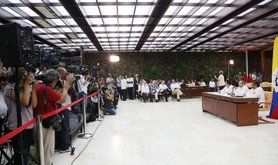
Colombia Peace Talks. Ramon Espinosa / AP/Press Association Images. All rights reserved.
In the first agreements reached in Havana, the Colombian government and the FARC have openly expressed their intention to promote citizen participation in the process of peace building. The issues on which agreement was reached - comprehensive rural reform, political participation, illegal drug trafficking, and the victims - highlighted the importance of citizen involvement. The agreements recognized that the “construction of peace is a matter for society as a whole that requires the participation of all, without distinction, including other guerrilla forces which we are inviting to join in” (General Agreement, 2012, page 1).
The agreements consider the contribution of communities in issues ranging from the drawing of local plans and programs – like the Development Plans with a Territorial Focus - as well as the surveillance, monitoring and control of their execution. They regard citizen participation as a complementary control mechanism of public administration and the system of political representation. Consequently, the peace process gives the strengthening of democracy a chance through the direct involvement of citizens.
It will not be possible to take advantage of this opportunity and stick to the intentions expressed in the agreements, however, if we fail to recognise the challenges that this citizen involvement in public affairs raises in today’s world and do not define the public sphere accordingly. This implies, among other things, taking into account the contribution of recent democratic innovations, especially those which exploit the potential of ICTs, in order to close the gap between citizens and the state.
The challenges of citizen participation in representative democracies
Our contemporary world has been described as an arena of fragmented relationships, empty public spaces, flexible social ties, and individuals who treasure their own time and pace. An arena where, according to Ken Newton (2012), more direct and individualized forms of participation prevail, quite different from the formal and traditional structures, and where citizens are less willing to invest huge amounts of time discussing public issues, and to commit themselves to changing them under current formats.
The dissonance between this kind of participation and the rigid structures of democratic political systems is instrumental in what many experts have diagnosed as a crisis of representative democracy. The high levels of abstention at elections, the low level of confidence in public institutions, the decrease in the membership of organizations, and the apathy regarding public affairs, all help to confirm and spread the idea of a weakened democracy where the gap between government and citizens is wider than ever.
In the case of Colombia, the data published by the Latin American Public Opinion Project (LAPOP) and the Social Capital Barometer (Barcas) support these claims. According to LAPOP, in 2014, only 9.6% of the population attended one local government meeting in the previous 12 months, and the average level of trust in local government scored between 40.1 and 45 on a scale of 0 to 100.
Regarding civic engagement, Barcas reveals a decrease in the percentage of citizens involved in voluntary activities between 2005 and 2011, and a decrease in the membership of secular, particularly agrarian and rural organizations. Similarly, political participation is diminishing due to lower citizen involvement in bodies such as the rural development councils, the citizen oversight boards, town hall open meetings, and the territorial planning councils.
Responding to this situation, state modernization and transformation projects undertaken by some Western countries have focused on the promotion and strengthening of direct citizen involvement in public affairs. But the assumption of this challenge and the vindication of the place of democratic practices in everyday life requires, in the first place, the overcoming of the notion of citizen participation as a face-to-face, binding, deliberative, highly informed and complex affair, capable of engaging allegedly motivated citizens. In this sense, it is important to imagine other ways to involve citizens - more practical, less costly and complex, more connected to the challenges facing public institutions, clearer and more transparent in their purposes and scope.
How have ICTs changed the ways in which the state and citizens relate to each other?
ICTs have changed the dynamics through which individuals relate to each other on a daily basis. It is thus not surprising that they be thought of as a means to alter the relationship between citizens and their governments and institutions. Experts like Archon Fung have found that as new channels of communication are being opened, their use in this field can change the way in which citizens influence the public sphere, and the way in which they interact with one another, with the organizations that represent them, their government and public institutions.
Despite the fact that very little evaluation has carried out on the effects of these tools in promoting citizen involvement, it is clear that they have the potential to modify the relationship dynamics between the state and the citizens. They affect the balance of power between them insofar as they make citizens less dependent on institutional channels to make their voices heard. They also give them the chance to have a more active and direct role in public affairs.
What ICTs do is open up new communication channels and pathways to access information: they reduce the spatial and temporal limitations of face-to-face interaction; they modify the social capital requirements; they ease contact between strangers; and they allow new and diverse ways in which people can express their opinion and preferences.
Here are some examples of the use of ICTs in the kind of context we are dealing with here: the digital participatory city-council budgeting in Belo Horizonte and Rio Grande do Sul, in Brazil; the World Bank monitoring and tracking system through Ontrack text messages in Bolivia, Uganda, Tanzania and Nepal; the online deliberative processes promoted by local governments in Germany and Italy; 3D role-playing games used for planning development and urban renewal exercises in the US; and the Peer-to-Patent Project and other governmental crowd-funding initiatives.
Citizen participation, ICTs and peace building
Overcoming more than fifty years of armed conflict, reaching national reconciliation, and preventing the reproduction of new cycles of violence requires the recognition of the effects that these phenomena have had on our culture, and tackling them. It requires making the decision to start a process of deep transformation of the ways in which we relate to each other.
Digital platforms, mobile apps, and multiple communication channels which make access to information and two-way interaction possible, allow citizens to come to know, dialogue and interact with other world visions. Since the Colombian conflict affected the possibility of dialogue between the different sides, a part of the challenge of peace building and participation has to do with opening spaces that can contribute to the recognition of differences, and with identifying converging and diverging points within the framework of collective building processes.
The launching of digital platforms can be an interesting way to promote the initial encounter between groups, people, or actors who, because of their conflict history and the mutual depictions that derive from it, may be reluctant to engage in face-to-face interaction. Role-playing games like Participatory Chinatown show the way in which technology contributes to the strengthening of empathic reasoning, and to changing initial preferences for the sake of collective well-being.
The challenges
While the role of digital tools in designing strategies and spaces to promote citizen involvement cannot be denied, it is obvious that the task cannot be carried out on the basis of false precepts and naïve perceptions.
Three key elements are relevant in the case of Colombia:
Institutional changes
One of the main reasons for dissatisfaction with the participation spaces is the low level of interaction between citizens and the state, which is something that depends far less on digital tools and technological innovation, and much more on the design of public management systems capable of offering quality answers to citizen demands. In order to launch effective processes of participation, both in face-to-face or virtual scenarios, governments must be clear about the ways in which the benefits derived from these processes will contribute to decision-making.
It is also necessary to make progress in incorporating citizen participation as a basic element in the modus operandi of governmental agencies, and in spreading the notion that participation is both practical and useful, and an effective and legitimate means to work on building the public sphere.
Inclusiveness
One of the very few studies available about the impact of ICTs on the development of participatory processes, by Tiago Peixoto, concludes that these tools do not necessarily promote the inclusion of the vulnerable or traditionally excluded populations. On the contrary, ICTs seem to be more effective in including traditionally non-participatory segments within the “privileged” groups - better educated and better positioned in society.
This is important, for we must think about ICTs from a perspective that includes a whole range of media, from TV and radio to more sophisticated mobile devices such as smart phones. Unless we do it, the use of ICTs to promote citizen involvement dynamics will end up contributing to the reproduction of the same inequalities that must be altered.
From the perspective of the Colombian juncture, it is also essential to defend that peace building is not only the responsibility of the vulnerable populations. ICTs are an option to attract segments of the population which, even if not highly affected by the conflict, have a lot to say in the collective challenge of overcoming half a century of armed conflict. We need to think about mobilising them for the endorsement of the agreements, which will require massive support from all Colombian citizens, not only those living in war zones.
Reconciliation
The use of ICTs has the potential to both claim and neutralise identities, and it can also contribute to either collective construction or polarization, depending on the devices used and their reach. Therefore, reconciliation must be present as a criterion for the design of both face-to-face and virtual spaces and interaction tools.
Choosing the most suitable approach across the spectrum of possible choices depends on the specific context, the topics to be dealt with, and the actors who are going to express their opinions. The options range from the opening of spaces for face-to-face interaction between the actors, to the promotion of platforms for virtual interaction with limited access and anonymous participation.
For instance, in places where some social actors are still at high risk, especially regarding issues of land restitution and victims’ reparation, platforms in which identity protection is guaranteed can be useful in the diagnosis and prioritisation stages. Useful, that is, to the extent that digital tools can be used for the free expression of positions and views which would be difficult to voice in face-to-face spaces.
Finally, it is important to note that the opening of channels of interaction between citizens and the state, and even between communities, implies overcoming above all the fear of social conflict, and rethinking the role of citizens in its resolution. It is necessary, therefore, to decentralise the debate about citizen participation, and to start a proactive dialogue at the local level on how to make digital tools play a positive role in the relations between communities and local governments - since these are the agents that will undoubtedly have to assume multiple responsibilities in implementing the peace agreements.
This text summarizes the main approaches developed in “Connected for Peace”, a document published by Fundación Ideas para la Paz in November 2015. The document in Spanish can be found at http://www.ideaspaz.org/publications/posts/1256.
Translated by Katie Oliver, member of DemocraciaAbierta’s Volunteer Program
Read more
Get our weekly email




Comments
We encourage anyone to comment, please consult the oD commenting guidelines if you have any questions.